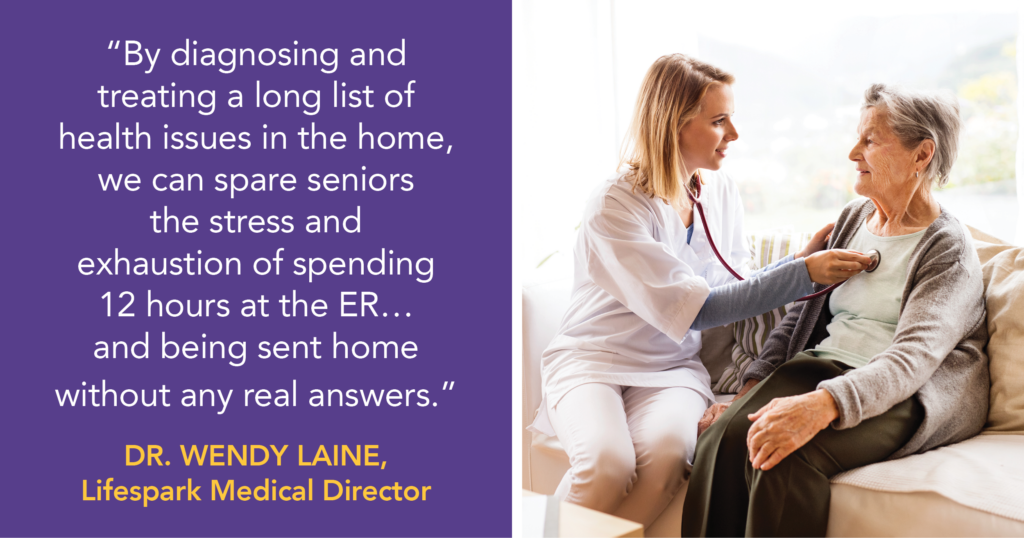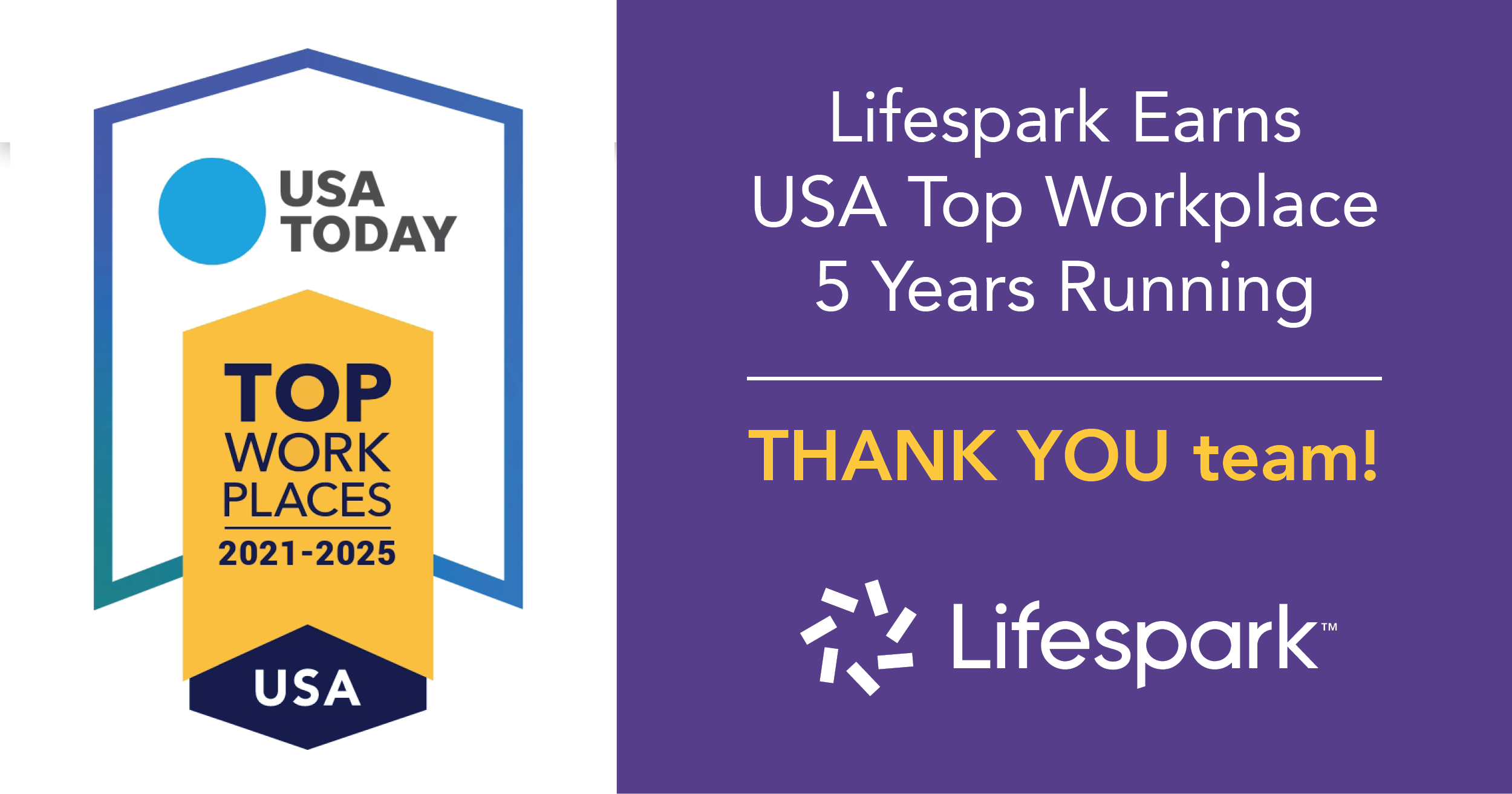
Before joining Lifespark’s primary care team, Wendy Laine, MD, spent 19 years on the frontlines of emergency medicine. She loved the work, but even before COVID-19 overwhelmed emergency departments and hospitals, the system was breaking down, she said. The result was long waits in crowded waiting rooms swarming with viruses.
“When I first started, if someone had to be admitted, we could get them transferred into a hospital room in less than an hour, which freed up space and staff for the next person,” Dr. Laine said. “But for at least the past five years, there’s been a boarding crisis with people waiting in the ER for anywhere from 12 hours to two days before an inpatient bed opens up.”
Alternative to the ER
Dr. Laine said she left emergency medicine in part because the system had become so dysfunctional and she felt powerless to make it better. What intrigued her about Lifespark was the opportunity to help older adults stay healthy at home which would also take some pressure off of emergency departments.
With the recent launch of Lifespark’s Urgent Response Services, that opportunity has been turbo-charged. Since June, the Urgent Response team, which includes Mobile Urgent Responders, has worked closely with Lifespark’s physicians and triage nurses to provide better, safer, and more convenient care for Lifespark COMPLETE members.
“By diagnosing and treating a long list of health issues in the home, we can spare members the stress and exhaustion of spending 12 hours at the ER, getting a CT scan and some blood work, and being sent home without any real answers,” she said.
Not your standard triage line
Lifespark’s 24-hour triage line has always been the first point of contact for clients with a health concern. “Just to be clear, our triage line is nothing like the standard triage line,” Dr. Laine said. “If you call your clinic’s after-hours line or the number on the back of your Medicare card, their only treatment option is the ER.”
In contrast, Lifespark’s triage team has immediate access to detailed client information—not only their health history and medications, but also their living situation, family support, contingency plan, and goals of care. All of these play a role in determining the best course of action for that individual.
In addition, Lifespark’s triage nurses have a leveling process which gives them a guideline to follow. For example, any indication of a stroke or cardiac event, a large bone fracture or a fall while on blood thinners is Level 5: call 911 and get to the ER. For Level 4, the Mobile Urgent Response unit is sent to the member’s home. For Level 3, one of the member’s providers or their Life Manager will see them the next day. For Level 2, the nurse makes a recommendation based on the member’s health history and sends a note to their provider. For Level 1, the concern is managed by the triage nurse.
Knowing a member’s goals of care is another huge point of difference, Dr. Laine said. “We have members on comfort care who’ve said that no matter what’s going on with their health—stroke, fall, fracture—they don’t want to be hospitalized. With a standard triage line, that’s never going to be an option,” she said.
Needs that don’t need the ER
According to Pete Carlson, VP, Lifespark Acute Response Services, more than 50% of emergency room visits are unnecessary. “Especially for seniors, the ER shouldn’t be the default alternative when health issues come up in between clinic visits,” he said. “We know that older adults can often be better served at home by a team of providers they know and trust.”
Acute health issues that can be diagnosed and treated by Lifespark’s Urgent Response team include urinary tract infections (UTI), wounds, diabetes-related neuropathy, hypertension, heart failure exacerbation, chronic obstructive pulmonary disease (COPD) complications, fall assessments, pain flare-ups, allergic reactions, gastrointestinal problems like nausea, vomiting and diarrhea, mental health issues, such as depression and anxiety, respiratory concerns, and dehydration.
Sometimes, people just need reassurance, Dr. Laine said. “Our members and their families appreciate being able to call us, have our team come out to do an exam and check their vital signs, and assure them that they don’t need emergency care.”
Avoiding readmissions
When a member does need to be hospitalized, Lifespark’s transitions team acts as a liaison between the hospital, the member, and their Lifespark provider team to let them know when the member will be coming home. “Those first few weeks after discharge are notoriously dangerous for older adults, so we make a practice of seeing them within seven days,” Dr. Laine said, adding that having extra support in those early days lowers the risk of another health crisis.
Recently, she visited a member in his home after he’d been hospitalized for chest pain. He was diagnosed with severe reflux and esophagitis and discharged with a cardiac diet. “When I walked in, he was drinking a large glass of orange juice. No one at the hospital had told him or his daughter that he should avoid acidic foods, like orange juice and tomatoes,” Dr. Laine said. “These transitions visits are critical to reducing readmissions.”
Better for seniors and ERs
When Dr. Laine and her team help a member avoid a trip to the ER, the reaction is often a mixture of awe and relief. “People will tell us, ‘This is amazing! My friends want to know how they can get in on this,’” Dr. Laine said, adding that she’ll sometimes send a text to her former emergency medicine colleagues to say, “Just spared you another visitor!”
As Pete has emphasized, the goal of Urgent Response Services is not ER avoidance. “We want the ER to be used for true emergencies,” he said.
To learn how Lifespark helps seniors stay healthy at home, visit Lifespark COMPLETE or call 952-345-8770.



